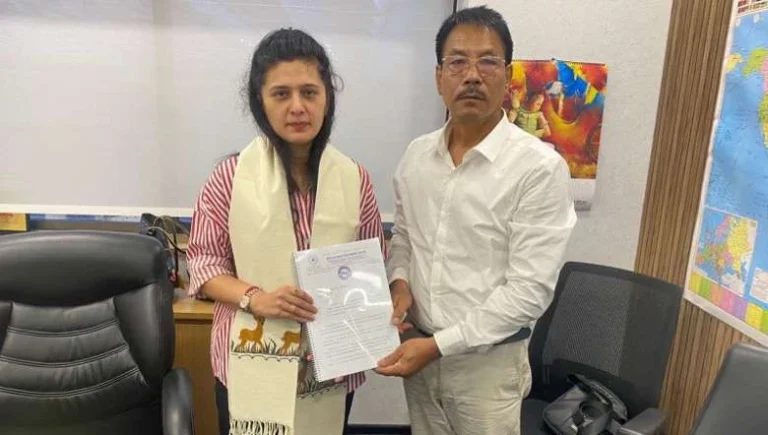Manipur Observes World Wetlands Day 2025: CM Highlights Initiatives for Wetland Protection
Manipur recently celebrated World Wetlands Day 2025 at Leishang Hiden, Canchipur, emphasizing the importance of wetland conservation. The event, organized by the Directorate of Environment & Climate Change, aligned with the UN theme, “Protecting Wetlands for our Common Future.” Chief Minister N. Biren Singh highlighted ongoing efforts to protect and revitalize the state’s water bodies, including restoration projects in Yarakpat and Lamphelpat, and announced significant beautification projects for Leishang Hiden and Imphal Turel.
Understanding the Significance of Wetlands
Wetlands are like the Earth’s kidneys, filtering pollutants and purifying water. They act as sponges, absorbing excess rainfall and reducing the risk of floods. Beyond their ecological functions, wetlands are home to a diverse range of flora and fauna, many of which are unique to these habitats. In Manipur, wetlands hold cultural and economic importance, supporting agriculture, fishing, and tourism.
Manipur’s Wetlands: A Precious Resource
Manipur boasts several significant wetlands, each playing a crucial role in the state’s ecology and economy. Loktak Lake, the largest freshwater lake in northeastern India, is renowned for its floating phumdis (heterogeneous masses of vegetation) and is the only habitat of the endangered Sangai deer. Other notable wetlands include Pumlen, Ikop, and Waithou lakes, each supporting unique ecosystems and livelihoods.
Challenges Facing Manipur’s Wetlands
Despite their importance, Manipur’s wetlands face numerous threats:
- Encroachment and Urbanization: Rapid urban development has led to the encroachment of wetland areas, reducing their size and disrupting ecosystems.
- Pollution: Discharge of untreated sewage, agricultural runoff, and industrial waste has degraded water quality, affecting both wildlife and human health.
- Invasive Species: Non-native species have altered the ecological balance, often outcompeting native flora and fauna.
- Climate Change: Altered rainfall patterns and rising temperatures threaten the hydrological balance of wetlands, impacting their ability to function effectively.
Government Initiatives for Wetland Conservation
Recognizing these challenges, the Manipur government has implemented several initiatives:
- Restoration Projects: Efforts are underway to restore degraded wetlands like Yarakpat and Lamphelpat. These projects aim to rejuvenate ecosystems, improve water quality, and enhance biodiversity.
- Legal Protections: The government has enacted laws to prevent encroachment and penalize activities that harm wetlands. Enforcement of these regulations is crucial for effective conservation.
- Community Engagement: Programs have been launched to involve local communities in conservation efforts, recognizing that sustainable management is best achieved with grassroots participation.
Chief Minister’s Announcements on World Wetlands Day 2025
During the World Wetlands Day 2025 event, Chief Minister N. Biren Singh made several key announcements:
- Beautification Projects: A ₹12 lakh beautification project for Leishang Hiden and an ₹86 crore project for Imphal Turel were unveiled. These initiatives aim to enhance the aesthetic appeal of these water bodies while promoting tourism and environmental awareness.
- Infrastructure Development: The approval of ₹3,300 crore for the construction of cemented concrete roads across Manipur was announced. Improved infrastructure is expected to reduce pollution and manage runoff more effectively, benefiting nearby wetlands.
The Role of Communities in Wetland Conservation
While government initiatives are vital, community involvement is equally important. Local communities can contribute by:
- Participating in Clean-Up Drives: Regular clean-up activities help maintain the health of wetlands and foster a sense of ownership among residents.
- Adopting Sustainable Practices: Reducing the use of pesticides and fertilizers in agriculture, properly disposing of waste, and conserving water can mitigate negative impacts on wetlands.
- Educating Future Generations: Schools and community groups can organize educational programs to raise awareness about the importance of wetlands and the need for their conservation.
The Future of Manipur’s Wetlands
The path to preserving Manipur’s wetlands is fraught with challenges, but with concerted efforts from the government, communities, and environmental organizations, a sustainable future is achievable. By valuing these ecosystems and implementing effective conservation strategies, Manipur can ensure that its wetlands continue to provide ecological, economic, and cultural benefits for generations to come.
FAQs
- What is the significance of World Wetlands Day?
- World Wetlands Day, observed on February 2nd, aims to raise global awareness about the vital role of wetlands for people and the planet. It marks the anniversary of the signing of the Ramsar Convention on Wetlands in 1971.
- Why are wetlands important to Manipur?
- Wetlands in Manipur support biodiversity, provide livelihoods through fishing and agriculture, act as natural water purifiers, and hold cultural significance for local communities.
- What threats do Manipur’s wetlands face?
- Major threats include encroachment due to urbanization, pollution from various sources, invasive species disrupting ecosystems, and the impacts of climate change.
- How is the Manipur government addressing wetland conservation?
- The government has initiated restoration projects, enacted legal protections, and engaged communities in conservation efforts to protect and revitalize wetlands.
- How can individuals contribute to wetland conservation?
- Individuals can participate in clean-up drives, adopt sustainable practices in daily life, and educate others about the importance of wetlands to promote their preservation.



